Here are all the details on Medinilla Plant Care, along with the Best Medinilla Varieties! Pick your favorite one out!
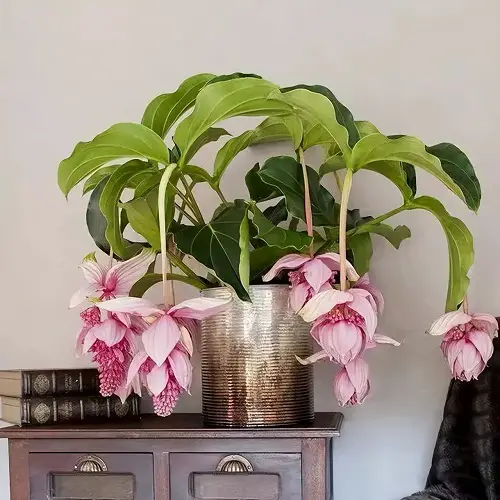
Medinilla Plant Care is really easy when you know all the right details about it! Check out the Best Medinilla Varieties too!
Common Names: Medinilla, rose grape, pink lantern plant, showy Medinilla, Philippine orchid
Botanical Name: Mednilla magnifica
USDA Zones: 10-11
Check out the Most Beautiful Pink Tropical Plants
Medinilla Plant Information
Medinilla magnifica, commonly known as the pink lantern plant or rose grape, is a tropical broadleaf evergreen species of plant. Native to Southeast Asia, it is often seen growing on tree branches and producing striking 18-inch flower panicles that hang down like clusters of grapes, creating a surreal sight for anyone who observes them.
It belongs to the Melastomataceae family and is renowned for its unique and attractive dark green foliage, which complements the panicles of flowers that look like clusters of small grapes. In some cases, Medinillas may also produce ornamental bracts at the base of their flower clusters, which appear like flower petals.
Medinillas are shrubs that remain green all year round and are indigenous to areas such as Java, the Malay Peninsula, the Philippines, and Sumatra. These plants have characteristic large leaves that can grow up to 14 inches long, contributing to their tropical appearance. A mature Medinilla shrub can grow up to 3-4 feet in height, it can be trimmed back after blooming to keep it manageable for indoor cultivation.
Medinilla plants have the ability to grow on other plants, such as trees or shrubs in the rainforest, a type of growth known as epiphytic. Despite using the host plant as support, Medinilla plants do not harm or draw nutrients from the host plant as a parasite would.
Look at the Flowers that Look Like Orchids
Propagating Medinilla

From Cuttings:
- To propagate Medinilla plants, select non-woody shoots that are at least 4 inches (10 cm) long during the plant’s fall or spring flowering period. Cut each shoot diagonally with a sharp knife and apply rooting hormone powder to the stems to enhance root growth.
- Make sure the cutting has a minimum of two leaves, but trim two-thirds of each leaf to reduce the burden on the stem.
- Plant the cuttings in suitable soil, such as sphagnum moss, and maintain warm and humid conditions.
- It’s advisable to keep the soil around the roots at a consistent temperature of 28-35°C, which can be done using a heating mat.
- You can create the necessary high humidity by covering the cuttings with a plastic bag, for example. After roughly four weeks, the first roots should start to form.
From Seeds:
- Propagation of the Medinilla plant can also be achieved by using its seeds.
- After the plant has bloomed, the fruit clusters it produces contain numerous seeds.
- A single fruit cluster can yield up to 2000 viable seeds.
- As Medinilla plants are species plants and not hybrids, the offspring grown from these seeds will retain the same characteristics as their parent.
- To extract the seeds, the ripe fruits should be crushed, revealing numerous seeds suspended in the fruit gel.
- Place the seeds in a bowl of fresh water and replace the water daily for several days to eliminate tannins that can hinder germination.
- To prevent damping off disease, plant the seeds on the surface of a sterile potting medium and cover them with a layer of milled sphagnum moss.
- Keep the soil moist until the seeds germinate, which may take up to a month.
- The seedlings are likely to grow approximately one inch per month and can take two to three years to reach flowering size.
Find How to Grow Dischidia Platyphylla Easily
Other Medinilla Species
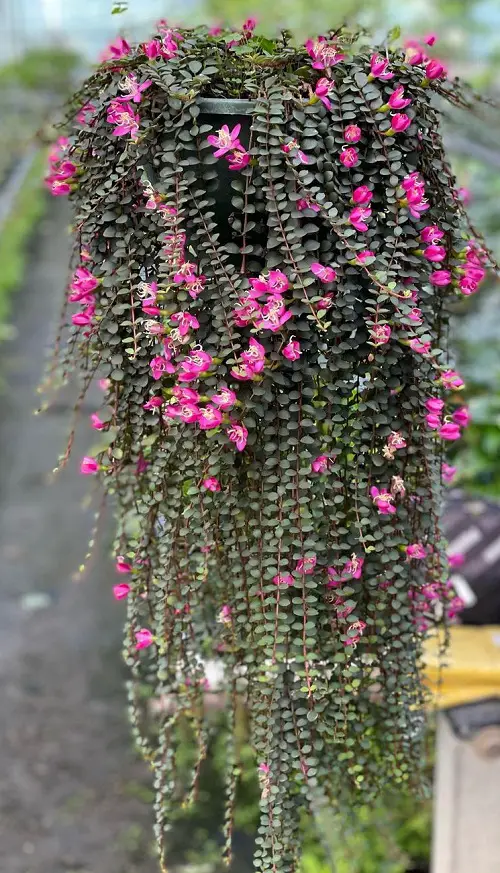
The Medinilla genus is characterized by its diversity, so it’s worth observing the subtle differences between species as you explore them. While M. magnifica is the most readily available plant and seed through a simple search, other species that are worth exploring include:
- Medinilla cummingii: This plant, also known as the chandelier tree, produces dense flowering panicles and yields purple to black fruits.
- Medinilla sedifolia: A diminutive plant that grows to be only 3 to 6 inches tall, it flowers twice a year with delicate magenta flowers measuring half an inch wide.
Look at the Best Types of Grevilleas
Requirements for Growing Medinilla
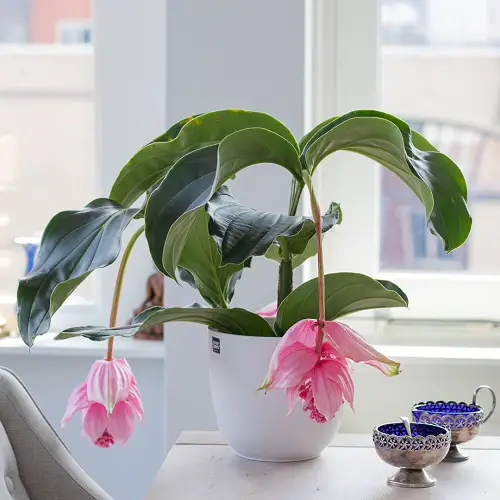
Light
The ideal location for Medinilla plants to grow well is in shaded areas with filtered sunlight, as exposure to direct sunlight can cause the leaves to wither or drop.
In its natural habitat, the Medinilla thrives in the rainforest, nestled within the lower branches of large trees where it receives dappled sunlight. Hence, to ensure successful growth, it is advisable to replicate similar conditions.
The plant will benefit from 2-3 hours of exposure to the mild morning sun.
Soil
Medinilla plants prefer a rich, well-draining potting soil with a pH of 6.5-7.5. The soil should be amended with a slow-release fertilizer to promote healthy growth. Additionally, adding organic matter such as compost or peat moss can help to improve the soil’s drainage and water retention.
Water
Water your Medinilla plant when the top 1-2 inches of soil is dry. If you forget to water it, the leaves will start to droop and become limp.
During the summer, you should water your Medinilla plant once a week.
In the winter, water it every two weeks. Make sure not to overwater your Medinilla plant, as this can cause root rot. If you have a humidity tray, make sure to keep it filled with water. This will help to increase humidity levels for your plant.
Temperature
The optimal temperature range for Medinilla plants is 65–75°F (18–24°C). Keep it away from A/C and heating vents.
Check out Stunning Vines with Pink Flowers
Medinilla Care
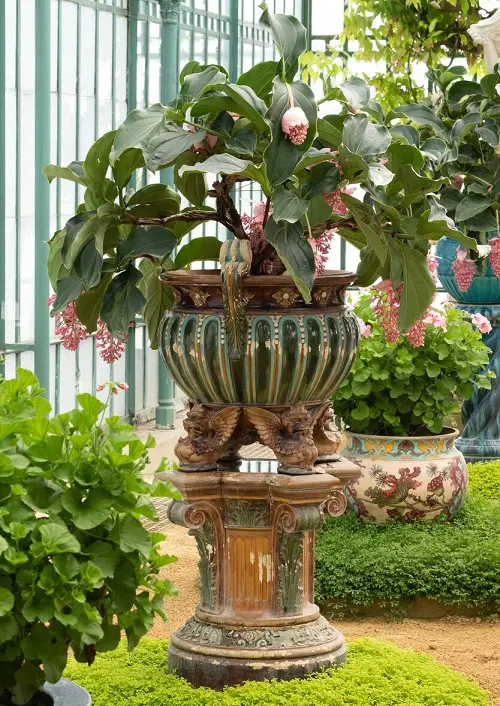
Fertilizer
Medinilla plants prefer a balanced fertilizer that contains equal amounts of nitrogen, phosphorus, and potassium.
A 10-10-10 NPK (nitrogen-phosphorus-potassium) fertilizer is an ideal choice for Medinilla plants. Apply the fertilizer around the base, following the directions on the package for dosage and frequency.
Repotting
It is advisable to re-pot your Medinilla plant before the onset of its springtime flowering, but only when it outgrows its current pot. It is crucial to take care when repotting as the plant’s roots are highly sensitive.
Damaging the root ball can cause significant issues such as leaf loss and other problems. Therefore, it is necessary to proceed with caution during the repotting process.
Pruning
Indoor potted Medinilla plants can be maintained at a manageable size by conducting regular pruning of the branches, especially after flowering. This practice helps to control the plant’s size and promote new growth. Eliminate withered blooms and leaves as well.
Overwintering Medinilla
In winter, Medinilla requires a rest period of eight to twelve weeks, during which new buds start to develop. To facilitate this, the plant should be kept in cooler conditions, with temperatures ranging from 50-70 F but not colder than 50 F.
Reduce watering in this period and water the plant when the topsoil is dry to prevent the root ball from drying out completely. Unlike in summer, the soil does not need to be constantly moist. It is not necessary to apply any fertilizer during this time.
Pests and Diseases
Mealybugs may occasionally affect Medinilla plants. If you notice mealybugs, use a cotton swab dipped in isopropyl alcohol to dab the insects. Additionally, spider mites may infest the plant in dry conditions, causing stress. Mist the plant regularly; it can help prevent spider mites.
If you notice brown leaves on your Medinilla plant, it could indicate waterlogging or dry air. Check the soil and repot the plant with fresh soil if necessary. It is crucial to ensure that the pot has a drainage hole to enable excess water to drain out.
Discover Beautiful Tiny Pink Flowers
Are Medinilla Plants Poisonous?
The question of whether or not the Medinilla plant is poisonous remains uncertain as it has not been scientifically proven. While it is generally assumed that the plant contains no toxic substances, this assumption is not entirely certain.
Therefore, to err on the side of caution, it is recommended that no parts of the Medinilla plant should be consumed.
Look at the Hot Pink Flowers
Best Medinilla Varieties
When people discuss the Medinilla plant, they are usually referring to the Medinilla magnifica variety. While it is undoubtedly a beautiful plant, there are many other Medinilla species that are equally breathtaking!
1. Crimson Medinilla

It offers glossy red blooms.
2. Medinilla magnifica ‘Flamenco’
The name is derived from its lively pink stems and flowers.
3. Rose-Grape Medinilla
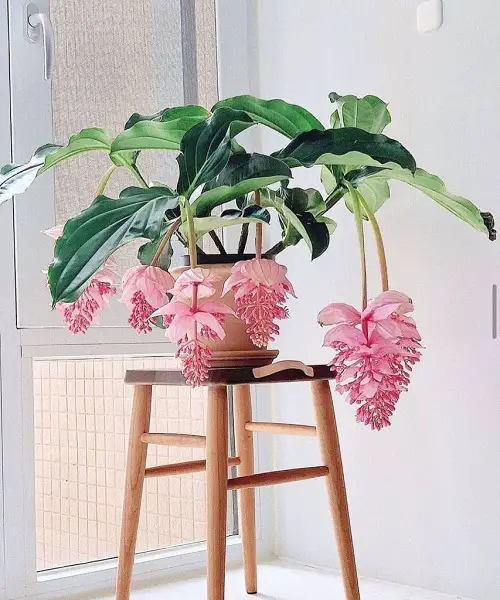
This easy-to-grow variety can withstand cool evening temperatures.
4. Pink Medinilla
The large bracts carry pink blooms and dark blue berries. It can reach up to 6 feet tall.
5. Medinilla magnifica ‘Dolce Vita’

This decorative cultivar, ‘Dolce Vita’ boast more flower clusters than the average medinilla.
6. Medinilla magnifica ‘Lambada’
It resembles in color to ‘Flamenco,’ but is a bit smaller in size.
7. Coral Medinilla
This low-growing variety top out at 12 inches.
8. Medinilla magnifica ‘Piccolini’
It is smaller than traditional medinillas, ‘Piccolini’ features beautiful leaves and flowers.
9. Medinilla sortechinii
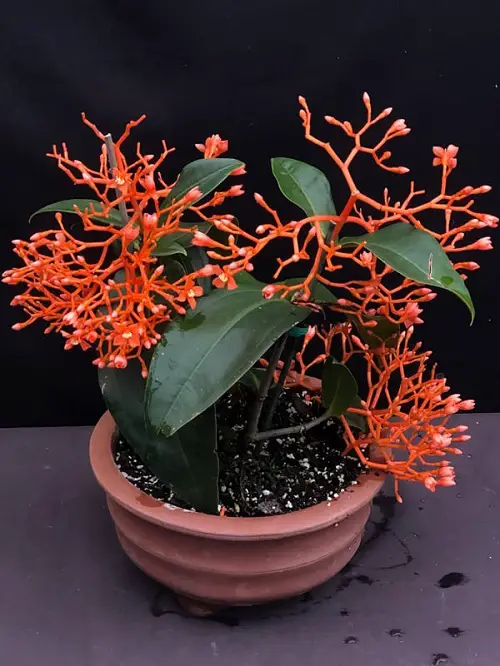
This distinct Medinilla offers orange-red, coral-shaped blooms.



